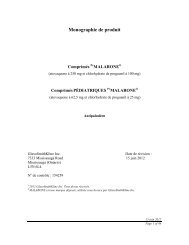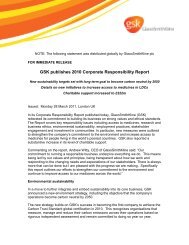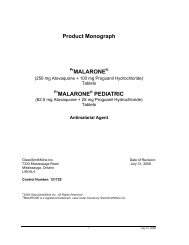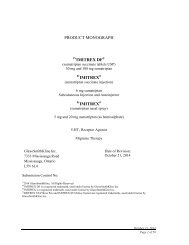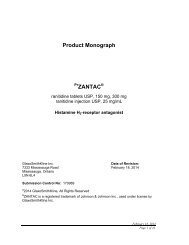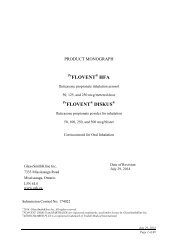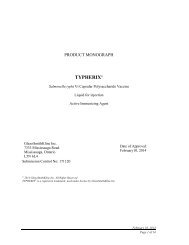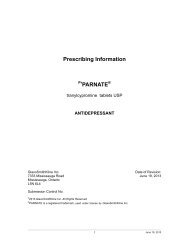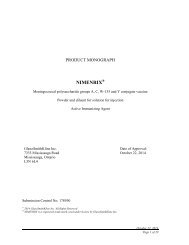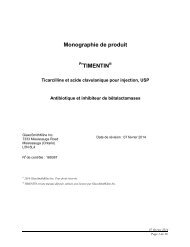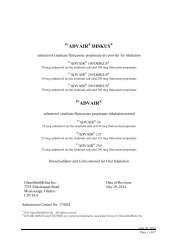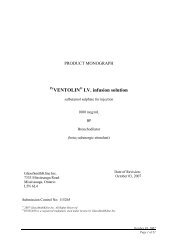Ventolin, Respirator Solution, Nebules - GlaxoSmithKline
Ventolin, Respirator Solution, Nebules - GlaxoSmithKline
Ventolin, Respirator Solution, Nebules - GlaxoSmithKline
Create successful ePaper yourself
Turn your PDF publications into a flip-book with our unique Google optimized e-Paper software.
while children with bronchitis or bronchiolitis did not respond well. Salbutamol was verywell tolerated in these studies. One author reported 2 cases of skeletal muscle tremor, butdrew attention to the fact that both patients received concurrent oral bronchodilator.Otherwise, the only reported side effect was occasional mild tachycardia.DETAILED PHARMACOLOGYClinical PharmacologyProlonged use of VENTOLIN ® (salbutamol sulphate) in most patients caused nosignificant changes in ECG pattern, blood sugar, liver and kidney functions andhematological values.The hemodynamic effects of intravenous salbutamol were studied in patients with mitralvalve disease. At the dose of l mcg/kg, salbutamol reduced mean aortic pressure by7 mmHg, increased the cardiac output by 0.6 L/minute and reduced systemic vascularresistance by 7 units. It caused no change in left ventricular ejection time. At the dose of2 mcg/kg, salbutamol increased the mean oxygen uptake by 21 mL/minute, narrowing themean arteriovenous oxygen difference by 10 mL/minute. Salbutamol has no effect on thepulmonary ventilation/perfusion ratio, therefore, unlike isoprenaline, it does not increasehypoxia during acute asthmatic attacks.Animal PharmacologyIn vitro studies and in vivo pharmacologic studies have demonstrated that salbutamol hasa preferential effect on beta 2 -adrenergic receptors compared with isoprenaline. While it isrecognized that beta 2 -adrenergic receptors are the predominant receptors in bronchialsmooth muscle, recent data indicate that there is a population of beta 2 -receptors in thehuman heart existing in a concentration between 10% and 50%. The precise function ofthese, however, is not yet established.The pharmacologic effects of beta-adrenergic agonist drugs, including salbutamol, are atleast in part attributable to stimulation through beta-adrenergic receptors of intracellularadenyl cyclase, the enzyme that catalyzes the conversion of adenosine triphosphate(ATP) to cyclic-3',5'-adenosine monophosphate (cAMP). Increased cAMP levels areassociated with relaxation of bronchial smooth muscle and inhibition of release ofmediators of immediate hypersensitivity from cells, especially from mast cells.The muscle-relaxing effect of salbutamol was found to be more prolonged than when theeffect was induced by isoprenaline. As suggested from the results of experiments inisolated animal tissues, salbutamol has been shown to produce a substantialbronchodilator effect in the intact animal. In the anaesthetized guinea pig, salbutamolcompletely prevents acetylcholine-induced bronchospasm at the dose of100 micrograms/kg intravenously.Administration of salbutamol aerosol at a dose of 250 microgram/mL for one minute toguinea pigs prevented acetylcholine-induced bronchospasm without any chronotropicOctober 2, 2014Page 19 of 37



